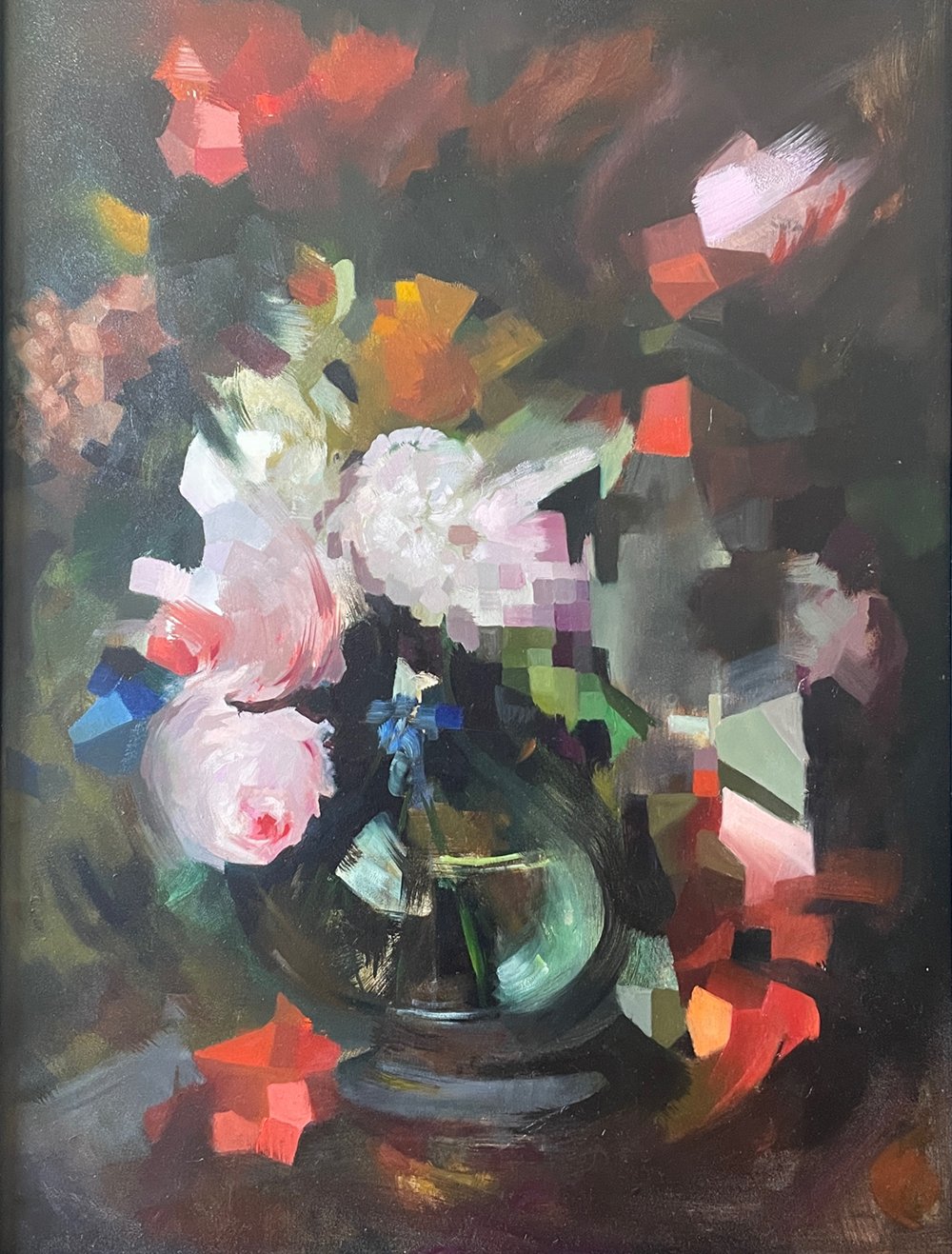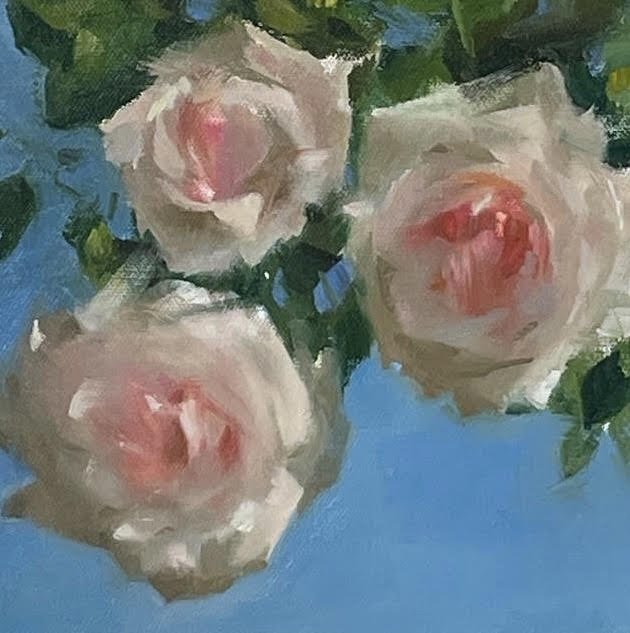Sophie M Cook
Sophie M Cook
Sophie M Cook is an oil painter residing in Kent, United Kingdom, with over fifteen years of professional painting experience. Her artistic journey commenced within the theatre industry, where she initially trained at the Royal Academy of Dramatic Art as a Scenic Artist. Subsequently, she expanded her artistic repertoire as a Fine Artist and pursued further education in drawing and painting techniques at an Atelier Art School. Sophie is renowned for her expertise in creating captivating still life paintings and exquisite floral compositions.
Sophie M Cook “Shape Shifting II – after Jan Davidsz de Heem” 2023
Artrepreneur: What is the role of technique in your art? How do you balance technical skill with expressive freedom?
Sophie M Cook: Technique is something I am always working on and developing. I am always striving to find a better way to lay the strokes of paint down, to create light effects that are true to the conditions and to establish better control in my colour mixing and palette management. I don’t always employ the same technique in my work as sometimes I work ‘alla prima’ and finish the painting in one sitting and other times I take an indirect painting approach and build the work up in layers from a monochrome underpainting. I have a tendency to work quite quickly so the alla prima technique lends itself quite well to my sensibility. To create a successful alla prima painting, it’s important to work from the general large masses to the smaller ones, keeping an eye on the whole throughout the process. Creating beautiful and interesting edges , accents and areas of contrast is where the technique can really shine. I always use big brushes, often flats and combers to achieve expressionistic and loose marks. To complete a painting in one or two sittings is very freeing and allows me to keep a sense of the emotion and connection I had with the subject at the start of the painting. My process relies so much on good colour management and an organised palette. I nearly always pre mix my colours in strings which allows me to paint more freely , immediately and with greater expression.
ATP: How do you handle artistic blocks or periods of creative stagnation? Are there any strategies you employ to overcome these challenges?
SMC: Artistic blocks nearly always come from exhaustion or periods of stress. I have just had a big exhibition in London which I spent a year working towards. It was a great show and a wonderful experience but the exhaustion really set in when it all ended. I am slowly starting to go back into the studio but made the mistake of rushing to create new work too soon. I made the decision to stop trying to create all the time and just take time to sit, read and sketch. I have been revisiting a few of my trusty art books and discovering new ones which has really helped to forge new ideas. I have read some books 5 times over and each time I learn something new. As your practice develops so too does your skill level and knowledge so certain teachings might not have resonated when you first encountered them. I have had several Eureka moments when looking back on well thumbed books.
I also really enjoy going to antique shops for inspiration. I love picking up old trinkets, vases and vessels, often letting the objects lead the new direction for my work.
Sophie M Cook “Jacqui’s Roses from Issigeac” 2023
ATP: How do you strike a balance between realism and abstraction in your paintings? What drives your stylistic choices?
SMC: This is an interesting question as people often tell me that my work sits in between realism and abstraction. I am very happy to be told this and this is where I like my work to sit. I have no interest trying to copy what is in front of me in a photorealistic way. Each object, flower or face that I paint as an essence or spirit and it is this which I’m interested in capturing. I am always searching for those connections between the object, its environment and my responses to it. I am nearly always led by colour and value relationships and try to establish harmonies in my still life set ups so that the background informs the objects and vice versa.
My atelier training has conditioned me to focus much of my practice on the formal aspects of painting such as shape, form, tone and texture from direct observation.
This inherited way of seeing is invaluable and has been incredibly useful in terms of understanding three dimensional representation and achieving realism. However, my natural inclination is to stop short of a fully resolved picture and to retain a sense of flux in the painting in an attempt to preserve that moment or sweet spot between realism and abstraction. To make a painting is quite different to making a picture and I feel that the poetry is lost if the artist chooses to create the latter. I love exploring the smaller shapes of objects in still life and how these interlocking tonal patterns create an abstracted three dimensional jigsaw. I want the mark making and constructional elements of my paintings to resolve figuration as a sort of tonal puzzle and always stop short of bringing the final image into sharp focus or full key. This sort of visual enquiry is what drives me to keep looking beyond the object and into the complexities of pictorial space and how best to capture it.
Sophie M Cook “Shape Shifters II” 2023
ATP: Looking ahead, what are some new directions or experiments you hope to explore in your future artwork?
SMC: I am always experimenting with different approaches to my painting. I have recently been using digital software to pixelate photographs of my paintings at various stages. This process forces me to look at both the painting and the still life with fresh eyes. I will often work over the painting with these references to hand, simplifying areas with more compressed tones or redesigning passages with a more deconstructed/pixelated approach. I used this method with ‘Shape Shifters – After Jan Davidsz de Heem ‘ which won best floral category on Artrepeneur’s platform. I used the Dutch Master’s composition in my own still life set up and played about with the shapes as I worked on the painting to create a semi abstract floral arrangement. Pixelating flowers in this way and painting the transitions as tonal squares feels like a logical shift from palette to canvas. The rendering and drawing might not resemble a flower but the brain is able to perceive it as such through the expression of tone and colour alone. I have plans to use Baroque and Medieval Art as the foundation for future works. Referencing the formal elements like colour and value to design my compositions and substitute figures for flowers in semi abstract form. My recent painting of Winchester Whites which I sold through my collective Floris Fine Art was actually based on the ceiling painting by Tiepolo at the Wurzburg Residenz in Germany. I love the dynamism and energy flowing through the figures in this huge work and wanted to personify the roses in this way as they trailed across the soft blue sky.
Sophie M Cook “Daffodil” 2023
ATP: Can you describe the significance of color in your work and how you approach color choices?
SMC: Colour is really significant in my work and is something I pay most attention to in my studies. As my work develops and my ability to see and mix colour improves I am less attached to trying to match exactly what I see in nature. I will usually try to find the most chromatic areas of the object I’m painting and work the others colours out from there. The points of high chroma as well as the lights and darks are a good place to start because they create the drama and framework of a composition. The less chromatic passages and neutral mixes are the chorus to the high chroma’s solo part. I often use the Munsell Colour notations to help identify the colours I want to design a painting with. The Munsell notations are great to help you identify the right hue, value and chroma of what it is you are painting. They help create a system and you can pre mix the colours with the aid of the notations giving you a solid, secure foundation to start the painting with more confidence. The Munsell system advocates the use of true neutrals made from ivory black, white and burnt umber as being the most useful neutral to reduce the chroma of any given colour without altering its hue. I don’t always deploy this approach in my mixing as I also really enjoying using complementary pairs to create more chromatic neutrals. I have been playing about with limited palette paintings recently and restricting the number of pigments to 3 plus white. It’s really interesting to work in this way as you have to really push the limits of the hues to expand the range and the results can be really surprising and fun.
To view more of Sophie’s work please visit her Artrepreneur profile.




